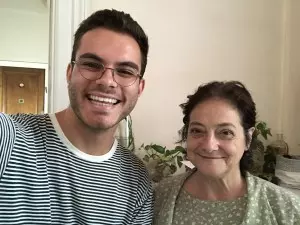Homestay: First Impressions


It was about 7:30pm on the last Tuesday in February, and I stood nervously by the door to the apartment building in Buenos Aires. I rang the buzzer, and a woman in her sixties came to the door, smiling from ear to ear. It was Vicky, my new host mom for the next four months. Once inside the apartment she showed me to my room and let me settle while she prepared some food. Over dinner, which consisted of milanesas de pollo with potatoes and a salad, we discussed many things, from the woodblock prints of San Francisco I had given her, to my recent trip to Brazil. As I crawled into bed that first night, I could feel myself growing content with this new homestay environment.
Instead of staying in a student residence or apartment, IFSA-Butler programs in Argentina provide you with a family to live with. The range of homes varies greatly, from location to family situation and everything in between. For me personally, however, the idea of living with a local family scared me. Would we get along? Would there be a strict curfew? What if I wanted to change my situation?
As the weeks go by, I’ve come to realize that a homestay is much like a college roommate. It is so often made out to be a perfect pairing, but the reality is more likely to require compromise. I’ve spoken to fellow students about our respective situations and experiences, and I’ve compiled our conversations here in respect to location in the city and family situation. We also discussed our concerns prior to arrival as well as advice we have for anyone concerned about a homestay.
Homestay Location Matters
I am in the Retiro neighborhood of Buenos Aires, a bustling commercial district just north of downtown. My commute to the IFSA-Butler office is 10 minutes on foot. There are restaurants, bars, parks and gyms, almost anything you can think of. The biggest downside so far is that I am the only student in this area, and I have to travel to meet up with friends. Isabela Escalona from Macalester College is in Villa Crespo, and describes her neighborhood as “very residential with all kinds of shops, restaurants, and other small businesses on the street level. It is walking distance from several bus stops and the B line of the Subte, the underground train system in Buenos Aires. It is also walking distance from Palermo, which is a popular area for nightlife.” Even though Isabela and I are in distant locales, we both have access to whatever we need close by.
Emory University student Shauna Kupershmidt lives with a host mom and dad, as well as four dogs in the Recoleta neighborhood. “It’s a beautiful home and beautiful location, and I have a private room and bathroom.” Bennett Nagurka from Vassar College is in Belgrano, and describes his situation as living with a “quirky retired scientist who has lived in the same apartment for 40 years and knows everything about Buenos Aires. We often talk about politics, Argentine history, and film. We have gotten very close over the past few weeks and I am excited to get to know her better as the semester continues.” My host mom lives with me and one cat in an apartment filled with plants. I have my own bedroom with a stunning view of Retiro’s Parisian architecture.
I have noticed that host families tend to be made up of an older woman who lives alone in one of Bueno Aires’ middle class neighborhoods. They can also be an older couple, and sometimes students have host siblings or relatives who live with them. Sarah Hinstorff, from University of Pennsylvania, tells me her favorite moment with her host family thus far, when she “[tagged along to] my host father’s 70th birthday party asado and [got] the opportunity to witness the entire extended family interact with one another.”
Expectations vs. Reality
Before I came to Argentina, I had a few concerns about my homestay. Both Isabela and I would have preferred to live in an apartment with other students or people our own age, and the idea of living with a family made us nervous. Now, she says, “I see a lot more pros to a homestay than cons. My host mom and I get along very well, and our time together allows me to practice my Spanish and learn more about everyday life and culture in Argentina. My host mom also hosts family parties every two weeks which allow me to practice Spanish and interact with people of ages I do not typically interact with as a student abroad, like young children, which can be a fun way to practice Spanish.” Sarah and I were both worried about communicating solely in Spanish, but I agree with her when she says that “this challenge has proven less of an issue than expected.” Generally speaking, most of the concerns that my classmates and I had about the homestay have dissolved after living here for a few weeks.
Lastly, my classmates and I discussed our advice for potential students considering a homestay program. Isabela’s biggest tip is to communicate with your family. “Many of the host mothers are middle or upper-middle aged, know tons of things about the city, have interesting stories and a lot we can learn from. Talk to them!” Shauna recommends preparing beforehand for “your lifestyle to be really different and to constantly need to think about respecting the people you live with; let them know if you are coming home, make sure you guard your key with your life, and prepare to converse during meals, but also to prepare for an incredible experience!” I couldn’t agree more. I feel immersed in Argentine culture through my homestay in a way that would simply not be possible if I had a different living situation.